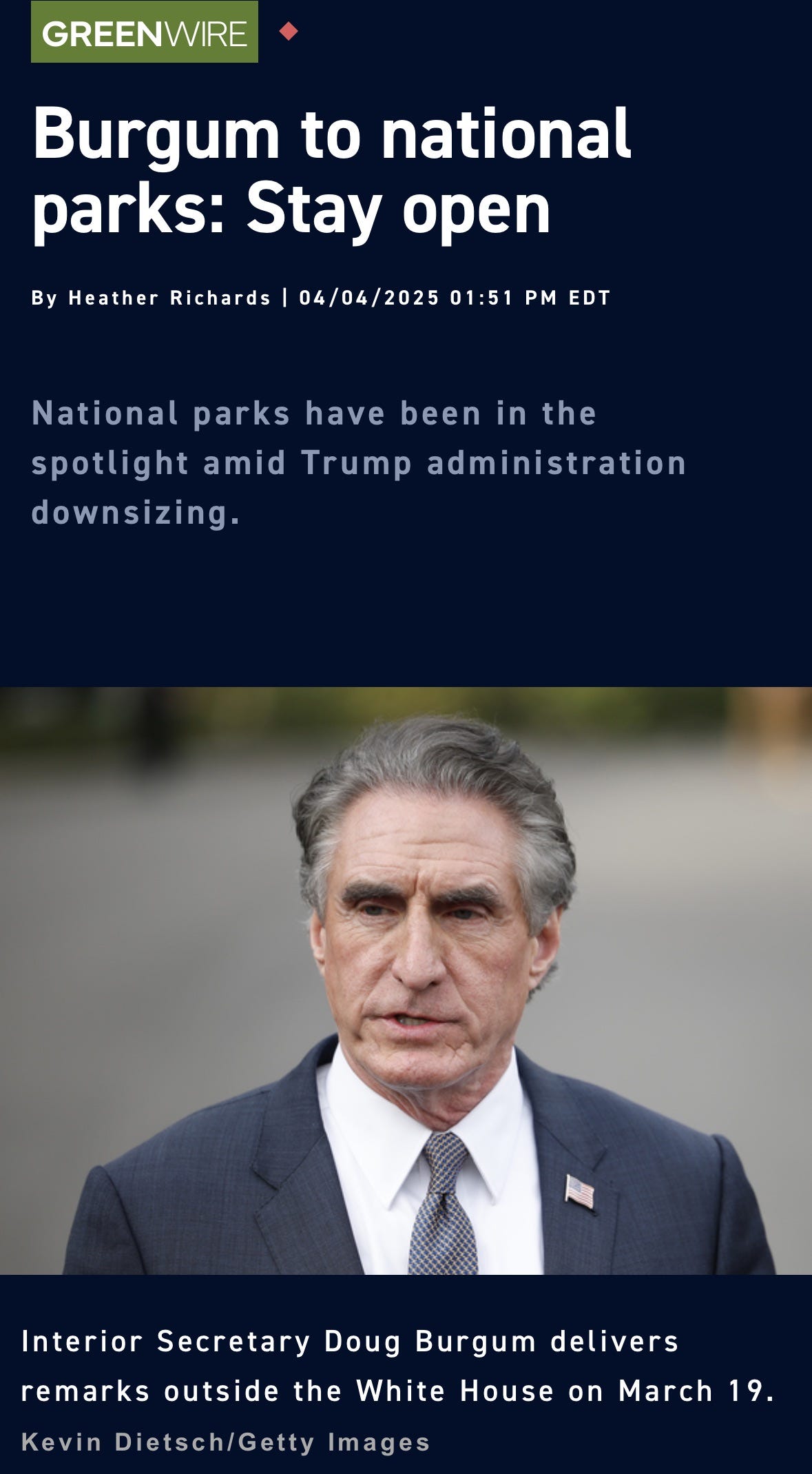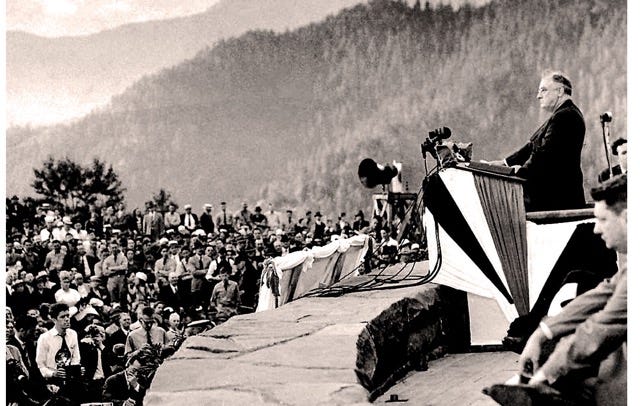This week, as American families plan summer vacations and communities like ours around National Parks fear impending damage and closures caused by callous DOGE firings of more than 1000 NPS staff, the Trump Administration issued strange new Soviet-style directives demanding that remaining staff cover for the firings and cease the long tradition of reporting visitation data.
The National Park Service has publicly reported these visitation figures since 1904, through Republican and Democratic administrations, but not anymore. As of this week, the new order is clear: NPS “should not issue a press release or other proactive communications, including social media posts.”1 The reasons for the stoppage are unclear, but the sinister order might as well say, “We fired a lot of important people for no reason, so there’s going to be a lot of bad news; don’t inform anyone.”
On top of this first-in-121-year information stoppage, Interior Secretary Doug Burgum issued another secretary-level order demanding that all national park services and sites remain open despite obvious staffing shortages. It’s seemingly designed to deny the physical reality of the very DOGE firings that he supported. “Any closures or reductions to operating hours, seasons, or any visitor services (including trails and campgrounds), in whole or in part, must be reviewed by the NPS Director and the Assistant Secretary for Fish and Wildlife and Parks.” Burgum went on to demand another headshcrather, promising “to ensure that NPS is properly staffed to support the operating hours and needs of each park unit.” Immediately following the order, Kristen Brengle with the National Parks Conservation Association raised serious concerns about what professional land managers believe to be the naive and irresponsible directive: “This ill-conceived policy flies in the face of responsible management of national parks, risking both visitor safety and the very resources the Park Service was created and is mandated to protect."2
Why is this happening now?
These detached-from-reality orders follow weeks of devastating DOGE staffing cuts and bungled partial rehires, leaving top-level managers at America’s national parks on edge about the upcoming season. The heightened concern of federal workers even outweighs the very real fear of political retaliation from an administration eager to use such tools. Just this week, it happened here in Northwestern Montana’s Glacier Park. “I’m standing here as deputy superintendent saying I don’t know what’s going to happen in Glacier in two months,” said Pete Webster at a March 24 meeting with the Glacier National Park Volunteer Association.3
The Daily Interlake, our local daily paper of record for Glacier country, captured the seriousness of the situation: “A 40-year employee of the National Park Service, Webster is well-versed in government shutdowns. He has weathered previous mass layoffs and transfers of power within the agency, but his voice often trailed off as he searched for the words to describe recent efforts undertaken by the Trump administration.
“This is different,” he admitted.
Webster’s highly informed statement directly contradicts Ryan Zinke, whose March 14 press release claimed, “Glacier has a plan moving forward to ensure the world class experience that Montanans and visitors seek will remain intact.”4
Meanwhile, some of the most popular attractions at parks south of here are already closed due to staffing shortages and management uncertainty. Backpacker Magazine announced one such instance with this March 27th headline: “One of Utah’s Most Popular National Park Hikes Closes Indefinitely Due to Staffing Shortage - With the park left severely shorthanded due to staff cuts, officials have closed the Fiery Furnace hike until further notice.”5
History tells us that economic recession makes this even more critical:
The Trump administration's tariff policies are pushing us toward recession, with many economists now stating that the chances are at least 60%.6 Consumer confidence is plummeting. Extreme Trump tariffs are siphoning trillions from American families' retirement and college savings plans. Inflation, which was already excessively high, is expected to rise again. Housing costs are astronomical, and the wealth gap continues to widen.
It’s in devastating economic times like these that the beauty and foresight of our national parks become more important, not less. Americans cherish these parks as places that help us reconnect with nature and heal from life's hardships. This was especially clear during and following the depression of the 1930s, when annual visitation to our parks skyrocketed from 4 million per year to more than 24 million.7 A similar trend was observed during the recession in 2008, when recreational visits to our parks increased by over 10 million in a single year. That year, Interior Secretary Ken Salazar noted what most Americans already knew: “People both here and abroad know that our national parks are America's best idea, even during an economic downturn.”8
Sadly, we are here again, staring down another painful economic downturn. But this time, we don’t exactly have an FDR at the helm of our national parks and public lands. Now our parks are entrusted to Elon Musk and a gaggle of DOGE kids with a warehouse full of AI servers.
But what about our representatives? Couldn’t they stop this? Why doesn't the secretary of Interior step up to help? Well, Ryan Zinke, Steve Daines, Tim Sheehey, and Doug Burgum are all very wealthy men. All can afford to jet off to a vacation any where they wish. Zinke spends most of his time on the California coast. Burgum is a Billionaire with a mansion in the Yellowstone Club, and so it's no surprise that none of them feel any need to slow the irresponsible staffing cuts and the weird secretarial orders.
For all of us that depend on these places, we are left to deal with the continued warnings from seasoned professionals and park advocates like Dan Wenk, a former Yellowstone Park Superintendent who told the SouthDakota Serachlight that Americans are going to see degradtion or closures at their parks; “I think it is going to have an impact this summer,” Wenk said, “especially as people start arriving in parks in the numbers that they traditionally do, and they expect the same kind of experience. It’s not going to be there for them.”9
https://mountainjournal.org/trump-administration-bars-national-park-service-from-reporting-visitation-data
https://dailyinterlake.com/news/2025/mar/30/uncertainty-reigns-in-the-crown-of-the-continent/
https://mountainjournal.org/trump-administration-bars-national-park-service-from-reporting-visitation-data
https://economictimes.indiatimes.com/news/international/global-trends/there-will-be-blood-jpmorgan-warns-of-60-global-recession-odds-under-trump-tariffs/articleshow/119965761.cms?from=mdr
https://southdakotasearchlight.com/2025/03/10/former-yellowstone-rushmore-badlands-superintendents-say-doge-wiped-out-a-generation-of-leaders/







The trump/musk/vance regime's hiding of information and outright deletion of parts of our history are sinister. That said, I'm buoyed up a bit having been with about a thousand other Hands Off protesters at the Capitol in Helena today. We will get through this. Ryan, it seems your "Get Your Montana Back!" has now widened to "Get Your United States Back!" And lots of ANTI-Daines, Sheehy, Zinke, and Downing posters out there today too.
This piece gave me chills. The quiet erasure of public information—visitation data, closures, even basic transparency—isn’t just bureaucracy gone wrong. It’s the symptom of an authoritarian mindset that treats truth like a liability. National Parks are sacred spaces, especially in hard times. What’s happening now isn’t just mismanagement; it’s desecration.
You can feel the playbook: fire the pros, silence the press, keep the appearances intact, and hope nobody notices until it’s too late. But people are noticing. And pieces like this are the reason why.
Thanks for holding the line, Ryan. This is resistance journalism at its best.